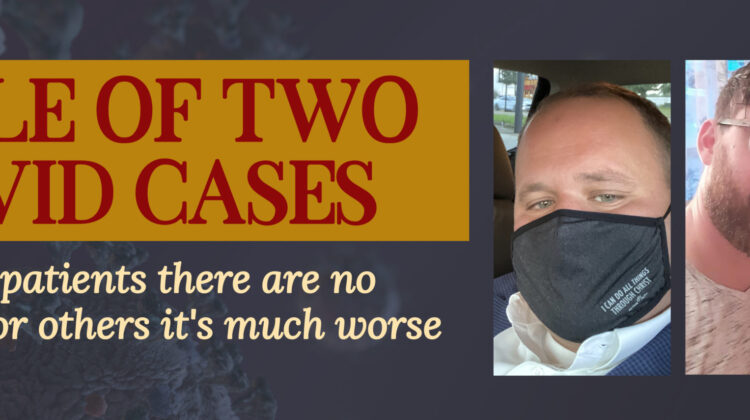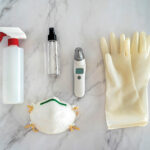
Nearly six months into the COVID-19 pandemic there may be more questions than there were at the beginning.
One of the biggest observations is the different ways the virus affects different patients, even when both patients are otherwise healthy.
“I don’t want to diminish the seriousness of COVID at all,” said Ben Dickey, a native Tipton Countian who was diagnosed four weeks ago. “I didn’t have any worse than a cold and some flu-like symptoms.”
Meanwhile, there are people like Dan Ridgley, of the Holly Grove community, who have been on ventilators fighting for their lives.
To date, 15 Tipton Countians have died, which is .98 percent of the current total confirmed cases.
The state does not release public data on the severity of symptoms for patients, but has said 78 people have been hospitalized in Tipton County. That number doesn’t include the people from Tipton County who’ve been hospitalized elsewhere.

And so, being diagnosed with COVID can be scary.
Ben, who now lives in Shelby County, said he was tested after being exposed to someone who tested positive. Days later he began feeling fatigued and felt like he had a sinus infection. He’d lost his sense of taste and smell, which is a key COVID-related symptom.
Two days later, on Aug. 14, he was told his test was also positive.
“There was fear,” he said. “I thought, ‘What now? Am I gonna die or am I gonna live?’”
For Ridgley, the diagnosis came about in a different way, his wife, Sadie, said.
At the beginning of July he was diagnosed with tonsillitis and was prescribed antibiotics. He was tested for COVID-19 on July 13 because his employer, West Tennessee State Penitentiary, asked that he do so before he returned from medical leave.
He was feeling better, Sadie said.
The week after, while awaiting his results, he began to feel badly. He had body aches, pain and was sweating a lot.
“He wasn’t really coughing and he didn’t lose his sense of taste.”
Two weeks later
The Tennessee Department of Health Thursday announced they’d changed the period of time in which they consider a patient recovered from 21 days to 14.
For many patients – the exact number is not known to the public – this is true. For others, even those who are not hospitalized, COVID’s affects linger beyond the state’s recovery classification.

Two weeks after his test Sadie took Dan to the emergency room in Shelby County. He was admitted to the hospital with double pneumonia. That same day his original results came back negative.
The hospital ran tests at the time of admission and he tested positive. It was July 29 and he was already on a ventilator.
“He called me himself and said, ‘This is probably the last time you’ll hear from me for awhile …’ I was crying, I broke down,” Sadie, who has been managing the couple’s home and three young children alone for more than a month, said through tears.
She and the children were quarantined for weeks and it was tough.
Ben, however, was recovered within two weeks.
He said he had indigestion (whether it was COVID or the hot wings he ate that night hasn’t been determined, he joked). He couldn’t sleep the first night and only coughed for a couple of days.
“It hurt to cough Friday, but Saturday I just rested and the cough got less and less,” he said.
His friend, who is a nurse on one of Memphis’s COVID units, brought him Emergen-C, Vitamin D and Zinc.
For the next several days he had minor symptoms, no fever, no sweating. The longest-lasting symptom was the loss of taste and smell, which lingered into his second week of illness.
“Because I was symptomatic, I could count my quarantine from the first days symptoms appeared and I was able to return to work after about 11 days,” he shared. “My roommate didn’t have symptoms, and didn’t test positive, but he’d been exposed to it and had to quarantine the full two weeks. That’s the current CDC recommendation.”
Ben wants to donate convalescent plasma, but he’s having a hard time doing it.
“I just want to be able to help other people.”
His story is not unlike most stories.
Statewide, only 4 percent of patients have been hospitalized and only 1.1 percent have died, but those stories are the ones being told.
“I was afraid because you hear so many of those cases, but you don’t hear the mainstream media talking so much about cases like mine. I just really wanted to share my story.”
In sharing his story he wants his message to be clear: “You shouldn’t focus on the fear, you should focus on what you can do.”
And those things are wearing masks, washing your hands and staying home when you’re sick.
Now that he’s recovered, he’s excited he was able to return to church for the first time in six months.
“It was so overwhelming getting to go in,” he said. “I just can’t describe it.”
From mild to a nightmare
Ben describes his case as mild, but Sadie has a much different descriptor for the family’s journey with COVID-19.
“I feel like I’m in my worst nightmare,” she said a few weeks ago, sitting on her couch under a framed print of Jesus cuddling a lamb. “We can’t see him, we can’t do anything to help him.”
By the time the health department called to talk to Dan about his original results, Dan wasn’t able to take the call.
“I told them that couldn’t happen,” Sadie said. “‘He’s on life support.’”
Dan has remained on the ventilator and extracorporeal membrane oxygenation, or ECMO, and has made great progress recently. He was expected to be taken off of ECMO Wednesday.
Sadie said he hasn’t had a fever in days and the fluid being drained from his lungs through the chest tube has looked better recently.
Rehabilitation is the next step.
It’s been five weeks so far without the man she calls her best friend.
The family attends Genesis Church in Munford and church members have organized a GoFundMe and meal trains to help with the financial aspects of Dan’s hospitalization.
Sadie is a stay-at-home mom and Dan’s paid time off ran out while he was hospitalized. COVID or no COVID, the insurance premiums and utility bills still have to be paid. Groceries still need to be purchased. They still need to have internet for school.
The original $5,000 goal was met pretty quickly, so organizers doubled the goal.
“We’ve always tried to live within our means,” Sadie said. “We live modestly so that we can survive off of just his paycheck.”
What’s ahead?
She said she doesn’t know how long of a road they’ll have ahead of them with COVID, but she misses the man she calls a great father, good provider and her inspiration to turn her life over to Jesus.
Sadie has been staying away from the news, away from the numbers and doesn’t want anyone to share their horror story.
They still don’t know how he contracted it, but it doesn’t matter.
One of their children tested positive, and was asymptomatic, but everyone else was negative.
At 40, Dan is young and has no pre-existing conditions. She does, however, so statistically speaking, she should have been the one sick.
“It just doesn’t make sense,” she said. “It just boggles my mind.”
For now, they just wait patiently and pray.
“There are other people suffering from COVID who are in worse shape than Daniel and their outlooks are grim,” she said Tuesday. “Let’s raise these people up and their families. We all know how hard this has been. It’s the absolute worse torture I have been through. It’s a complete nightmare.”
For more information on fundraising and other support efforts for the Ridgley family, see https://www.facebook.com/donate/670471113560579/.






Leave a Reply